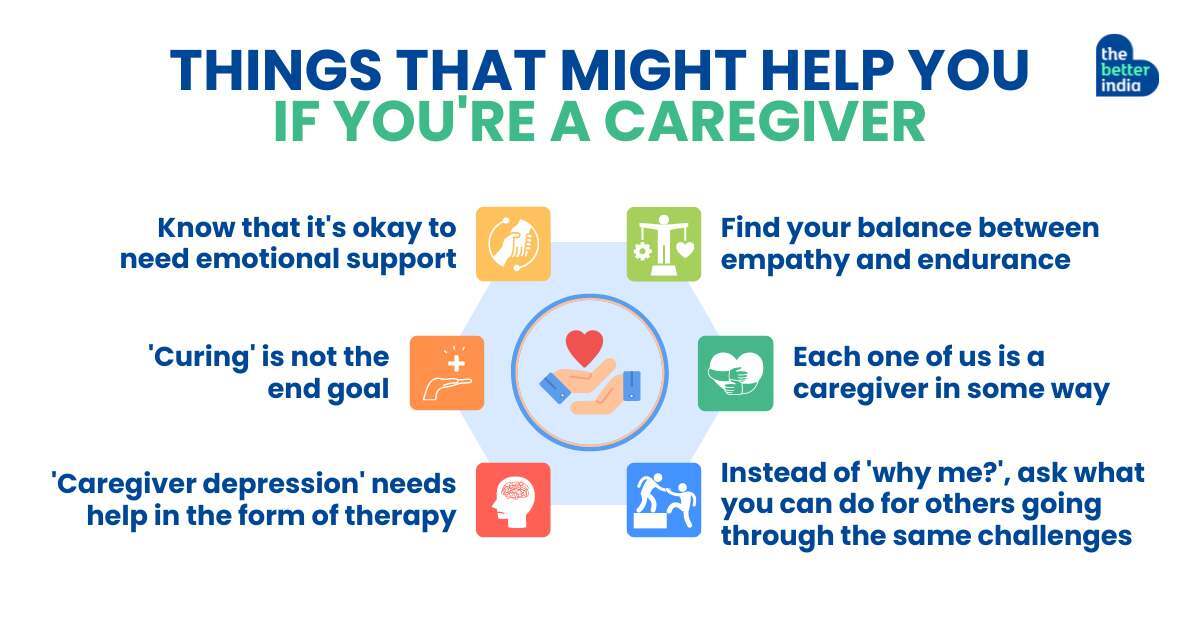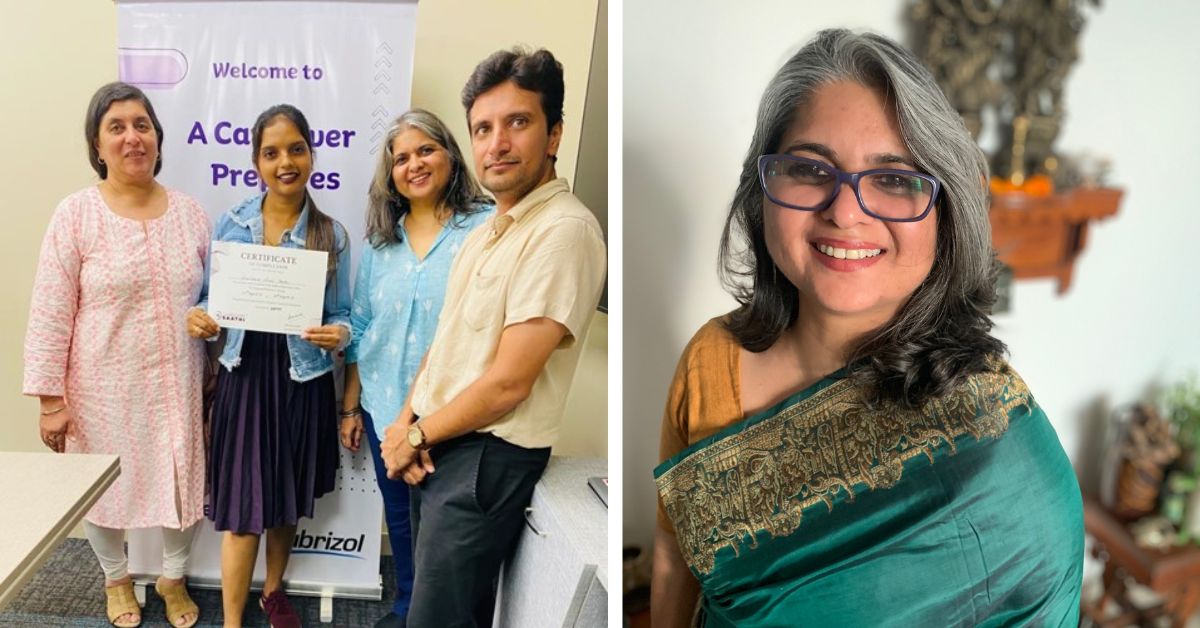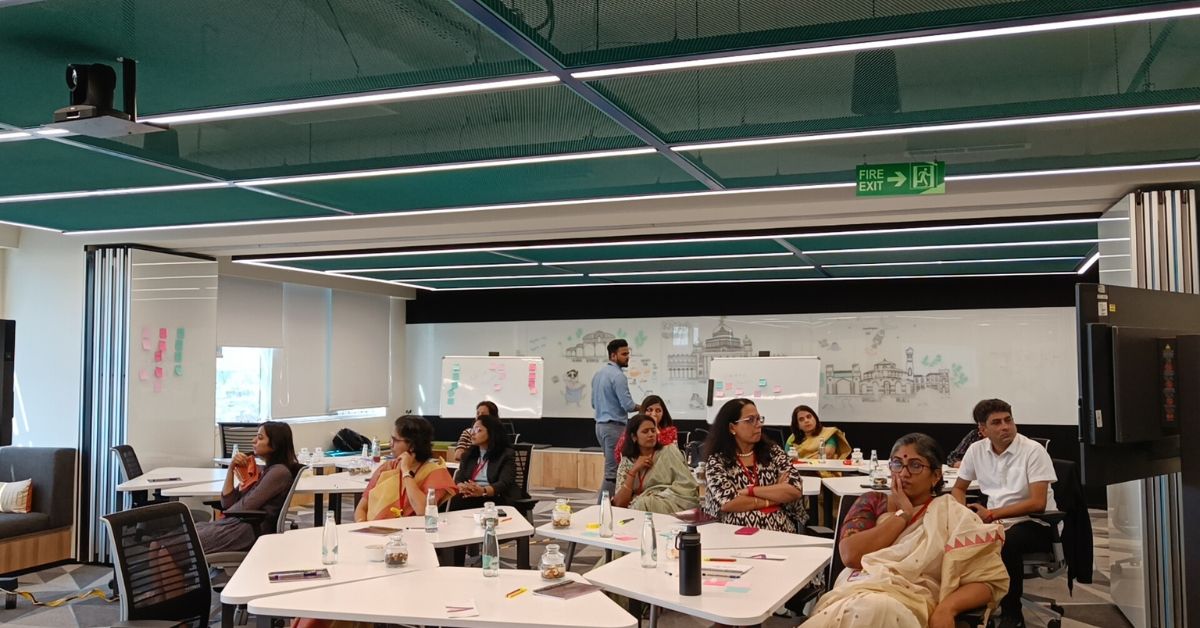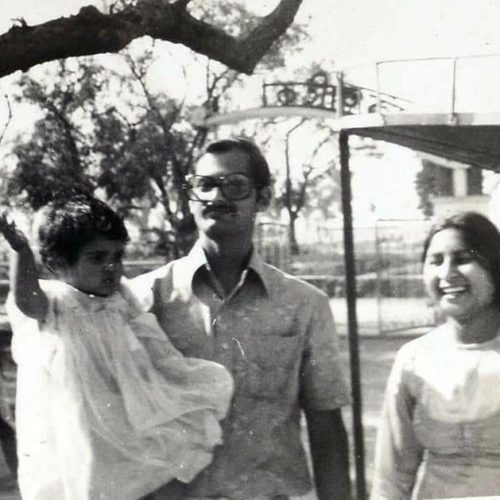“Zindagi badi honi chahiye, lambi nahi.”
To you, this may be reminiscent of a popular Bollywood movie dialogue. To 50-year-old Bhavana Issar, it has been the crux on which her life and work stand. While her foray into caregiving formally started in 2019 when she turned entrepreneur, Bhavana has been a caregiver since her early twenties. And there are many lessons to be gleaned from her journey, both personal and entrepreneurial.
When one of her interns at her Mumbai-based organisation ‘Caregiver Saathi’ — a platform empowering people taking care of patients with chronic illnesses — told Bhavana she wouldn’t be able to continue her internship since “there was a lot to be done in the house and her mother needed her”, the latter was shocked, but not surprised.
Aside from making her privy to the realities (as you’ll read ahead) unfolding among young employees in India, the conversation took Bhavana down memory lane to a similar one she had had with her mother following her father’s diagnosis of Multiple System Atrophy (MSA) when she was barely 21.
She cannot help but draw parallels with it. On the brink of pursuing an MBA (HR) at the time, Bhavana was in two minds about whether to continue or instead get a job to support the family financially. But her parents wouldn’t hear of her putting a stopper on her dreams. They insisted that the diagnosis did not change her goals in the least.
“My mother was keen that I grow into a working professional who is financially independent. Both my parents insisted that I complete my studies as I had planned and then start working,” she shares.
Bhavana’s story is an outlier when it comes to caregiving in India. A July 2023 report by BCG sent shockwaves through the industry when it reported that up to $250 billion in GDP could be in jeopardy across six Asia-Pacific countries (Australia, China, India, Indonesia, Japan, and Singapore) by 2035, as more and more employees — the average is driven by women, according to Bhavana — become full-time caregivers.

“Managing the responsibilities of caregiving and employment requires time, flexibility, and energy, and affects well-being at home and work. If employed caregivers don’t get the support they need to be both caregivers and productive members of the workforce, a talent exodus could ensue — costing companies and draining national coffers,” the report went on to add that the numbers of employee-caregivers across the six nations is set to grow by 100 million to a total of 1.2 billion in 2035.
Three decades ago, Bhavana could have well become a statistic if not for her mother’s support, something she hasn’t forgotten. In the years that succeeded that conversation, she aced the corporate ladder, going on to become a leading HR professional with 15 years of experience to boast of today.
But the inflection point — that led to the birth of Caregiver Saathi — came in 2013, following a motorbike ride.
An ecosystem for caregivers
As anyone who knows Bhavana well enough will tell you, her favourite weekend pastime is to whizz through the city of Mumbai on her beloved Royal Enfield Thunderbird 500. Curious glances coloured with amusement don’t fluster her anymore.
“They never did,” she points out. “Growing up, I was never made to believe that a girl riding a motorbike was something unusual. I come from a family where girls were educated and encouraged to be bold and brave. I think in many ways that has contributed to my work. It was like an inheritance — a gift, if you will.”
Through the years, the motorbike rides took on many avatars — from being a mode of transport for running errands (in her college days) to a loved hobby (in her care-free years) and even a form of therapy (on days when she needed to channelise the grief of her father’s passing). The motorbike has been a silent witness to her best and worst days; it was also the first audience the day 39-year-old Bhavana decided to test entrepreneurial waters.

“Following my dad’s passing, I became a caregiver to a few people in my family who were dealing with certain conditions. I continued to shoulder my responsibilities but somewhere the mental load of not being able to talk about these things took a toll on me,” she shares.
“Looking back, I feel I may have gotten burned out,” she continues. “My life had lost its meaning and purpose.”
Recalling the details of that particular bike ride that turned out to be revelationary in many ways, Bhavana says, “I began thinking about what I wanted to do with life. My dad was 54 when he passed away. The question ‘What if I don’t have enough time?’ kept nagging me. I wanted to make my life meaningful.”
And that’s how Caregiver Saathi was born.
Why caregiving?
“From seeing my mother’s challenges while caring for my dad to being a caregiver myself, I realised how unresolved grief can be burdensome,” she responds. In hindsight, she saw Caregiver Saathi as an attempt to transform the pent-up grief she was carrying with her into something that would help other caregivers.
“I wanted it to be a platform for working women who find it hard to balance caregiving and their financial independence,” she notes.
Monetisation wasn’t her priority in the initial years, she says. “I spent a lot of time engaging in storytelling to create awareness and creating conversation around what could be done for caregivers.” But the COVID-19 pandemic sparked the idea of a corporate model.
According to a Forbes article that quotes statistics by Global Carer Well-Being, 25 percent of Gen Z and Millennial caregivers were in caregiving roles for the first time during the pandemic, compared with 15 percent of Gen X and Boomer caregivers.
“I began to realise that organisations must worry if their employers were quitting to become caregivers as that would mean a loss of team members,” Bhavana notes. She adds that many conversations led her to believe that it was women who quit their jobs when posed with a problem in the house where a caregiver was required. To this end, Caregiver Saathi was designed with this reality as the cornerstone.
“If an organisation wants to retain women in their workforce, they will want to provide them a support system. We are creating a technology-based platform in which women who are providing care can get all the support that they need,” she adds.
Explaining Caregiver Saathi’s offerings with an example, she says, “A mother who has a son with autism should be able to find everything she needs on Caregiver Saathi; a help who can come and spend time with her son a few days in the week, a good doctor, a support group for parents of autistic children, or even a wheelchair within budget.”
Through the last few years, Caregiver Saathi has grown to encompass workshops, coaching, skill training, and counselling for individuals who are caregivers to people diagnosed with cancer, dementia, ALS, etc. In addition to this, their corporate model includes advisory services and interventions through which the workplace can be made a caregiver-friendly space.
A multitude of learnings colour Bhavana’s journey. She shares them with others who might need it.

‘It’s okay to need a shoulder’
Watching one’s dad transform overnight from being a fit Air Force pilot to not being able to walk a step, changes one in ways that cannot be put into words, likewise for Bhavana. But she recounts how the resilience and compassion displayed by her mother and grandmother were antidotes to the family’s toughest moments. “Caregiving teaches one to be kind and compassionate in the true sense because you are doing good without expecting anything in return,” she says.

She goes on to share a story that shows how caregiving marks the perimeters of our very existence as humans.
When anthropologist Margaret Mead was once asked what according to her was the first sign of civilisation, she replied ‘a healed femur bone’. “One of the strongest bones in the body, if the femur were to break it would essentially mean death. But the fact that the bone showed healing meant that someone had cared for this person,” Bhavana elaborates.
Know about caregiver depression
When Bhavana’s dad was diagnosed with multiple system atrophy — a condition notorious for tremors, autonomic dysfunction, and the muscle rigidity it causes, she experienced a different kind of grief — anticipatory grief; a grief for the inevitable reality. Today, the spectrum of feelings (including hopelessness) comes under the umbrella of caregiver depression. “Studies say there is a very strong correlation between death by suicide and caregiving because both feel like you’re dealing with something hopeless,” says Bhavana.
Don’t look to cure anything
What helped Bhavana was when, instead of looking at her caregiving as a way of healing the person (which wasn’t possible), she began to see it as a way of helping them. “It is important that the person you’re caring for should have a full life. You have to remember that what we are doing is adding life to their days and not the other way around. At the end of the day, the purpose of life is judged by how you helped others live theirs.”

Find your balance
Don’t let the brutality of it all get to you to the extent that it makes you numb. “Empathy fatigue is not the way to deal with grief. Instead, find ways to be compassionate to support someone who is vulnerable,” Bhavana says, adding that the balance is where the beauty lies.
Transform your grief
If her journey has taught her anything it is that grief is a powerful resource. But instead of becoming a victim, she says, the key is to go through the situation in a meaningful fashion that will help you transform, not just your life but the lives of others too. “Accept vulnerability,” she says. “In my college years, I often had no one to talk to about what I was going through. But if you have a support group, turn to it.”
You are a caregiver even if you don’t know it
Writer and activist Rosalynn Carter once said that there are only four kinds of people in this world — those who have been caregivers, those who are caregivers, those who will be caregivers, and those who will need caregivers. This quote converges on a truth — each of us is closely linked to caregiving. “In fact, many of us will be in more than one of these categories in our life,” Bhavana says.

Instead of ‘why me?’, ask…
Brushing grief under the carpet is a temporary solution, Bhavana smiles. “Years of doing this led to it creeping up on me one day.” While the 21-year-old Bhavana did not have the time to sit and question life about why it had dealt her an unfair hand, the 50-year-old Bhavana knows better.
“Instead of thinking ‘Why me?’ I said ‘What about others like me?’ And that’s where the second chapter of my life began,” she remarks.
Edited by Pranita Bhat.
No comments:
Post a Comment